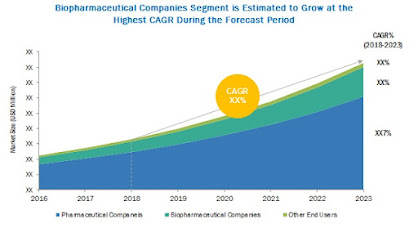[118 Pages Report] The Compound management market is projected to reach USD 424.5 million in 2023 from USD 215.3 million in 2018, at a CAGR of 14.5% during the forecast period.
The growth of the market can be attributed to increasing drug discovery activities, the growing biopharmaceutical industry, and the rising trend in outsourcing compound/sample management.Market Dynamics
- Increasing Drug Discovery Activity
- Growth of the Biopharmaceutical Industry
- Rising Outsourcing of Compound/Sample Management
- Growth of the Biobanking Sector
“By sample type, the chemical compounds segment to account for the largest share during the forecast period.”
The rising drug discovery activity is leading to an increased demand for compounds, which is positively affecting market growth.
Download PDF Brochure @ https://www.marketsandmarkets.com/pdfdownloadNew.asp?id=182172928
The outsourcing services segment is projected to register the highest CAGR during the forecast period. This high growth is due to the shift in trend towards outsourcing compound management to third-party service providers. These companies are experts in compound management and provide various services to pharmaceuticals, biopharmaceuticals, and CROs with regard to their compound storage needs, and are reasonably priced.
The geographical regions mapped in the report are:1. North America2. Europe3. Asia-Pacific4. Latin America5. Middle East and Africa
The large share of North America is attributed to the presence of the large pharmaceutical and biopharma industry. As a result, several companies in North America are engaged in drug discovery activities, which require the maintenance of substantial chemical libraries. Moreover, to maintain the productivity of such innovative drugs and biologics, most of the leading pharma and biopharma companies have started building compound management facilities or contracting external service providers.
Some key players mentioned in the research report are:
Brooks Automation (US), Hamilton Company (US), TTP Group (US), Labcyte (US), Biosero (US)
Request for sample pages @ https://www.marketsandmarkets.com/requestsampleNew.asp?id=182172928
















